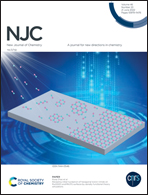Amino-functionalized magnetic porous organic polymer for the selective removal of toxic cationic dyes from textile wastewater†
Abstract
Porous organic polymers (POPs) with fascinating porous properties are promising candidates for the removal of organic dyes from textile wastewater. In this research work, an amino-functionalized magnetic POP (FC-POP-EDA@Fe3O4) containing accessible binding sites was successfully synthesized in three steps: (1) the Friedel–Crafts reaction between fluorene and cyanuric chloride, (2) fabricating amine-end capped POP using 1,2-ethylene diamine and (3) magnetization of amino-functionalized POP through fast reduction based on a co-precipitation method. The porosity and crystallinity of the synthesized adsorbent were characterized using the nitrogen adsorption/desorption isotherm and X-ray diffraction patterns, respectively. The results indicated the mesoporous structure of FC-POP-EDA@Fe3O4 with well-defined crystallinity and a specific surface area of 402.11 m2 g−1. The synthesized FC-POP-EDA@Fe3O4 exhibited superior adsorption toward the cationic dyes in comparison to the anionic ones. This is associated with the POP adsorbent surface charge determined using the zeta potential analysis. In this regard, for the synthesized POP, the maximum adsorption capacities of 379.75, 240.9, 32.13, and 40.28 mg g−1 were obtained for basic red 46, basic blue 41, direct scarlet 4BS and acid naphthol 6B, respectively. According to the results, FC-POP-EDA@Fe3O4 is a promising adsorbent for the selective removal of cationic dyes from textile wastewater.



 Please wait while we load your content...
Please wait while we load your content...